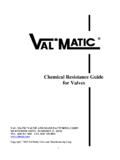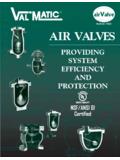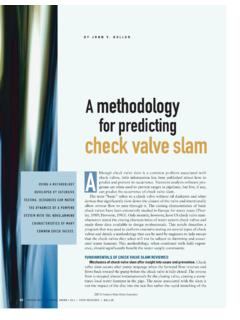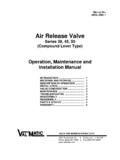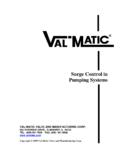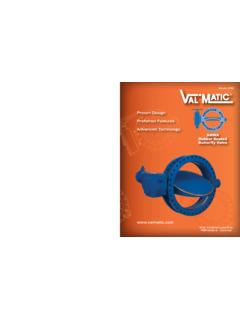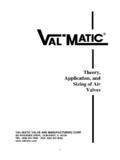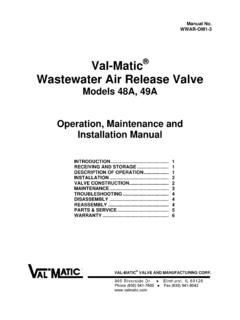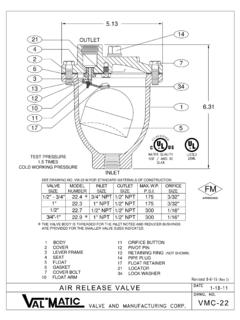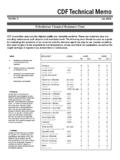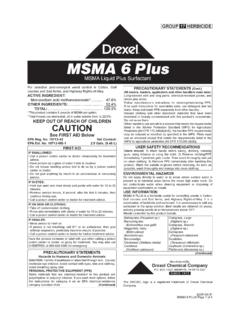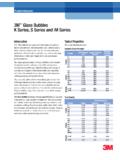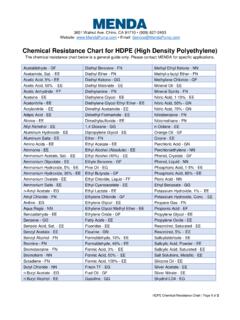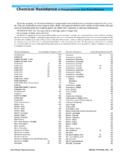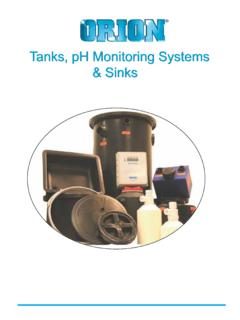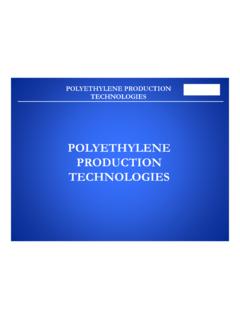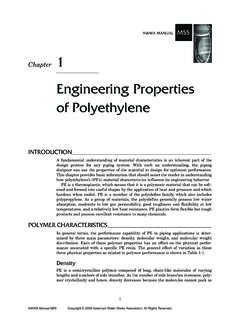Transcription of Chemical Resistance Guide - Val Matic
1 Chemical Resistance Guide Table of Contents Purpose.. 2 General Properties of Elastomers and Plastics.. 3 General Properties of Metals .. 4 Chemical Guide Table for Valves .. 6 VM CRG/WP Val Matic Valve & Mfg. Corp. PH: 630 941 7600 Copyright 2018 Val Matic Valve & Mfg. Corp. White Paper Chemical Resistance Guide 2 Purpose This Guide was developed by Val Matic Valve and Manufacturing Corporation as a convenience to its customers and should be utilized only as a Guide for the selection of valve materials. Mixtures and other Chemical concentrations of chemicals are beyond the scope of this Guide .
2 Performances of materials in existing systems also offer valuable information in predicting valve performance. Information given in the table consists of the maximum recommended temperature for the listed material in F or a letter designating: A = resistant under normal conditions B = conditional Resistance , review performance C = not recommended blank = no data available Val Matic offers no warranty or representation as to the accuracy or completeness of these tables. Use of these tables should be made under the direction of trained engineers or design professionals exercising independent judgment regarding the suggested use of the valve types and materials. Chemical Resistance Guide 3 General Properties of Elastomers and Plastics Aflas is a fluoroelastomer compound that has excellent heat Resistance with continues service temperature capability of 450 F and good Chemical Resistance , including Resistance to strong acids and bases.
3 Aflas also has excellent oil Resistance . Buna N (Nitrile, NBR, HNBR), or copolymer of butadiene and acrylonitrile has excellent Resistance to petroleum products, lubricants, and water over a wide temperature range of 50 to 200 F. Nitrile is a widely used elastomer for hydraulic system O rings. Buna N does not have good Resistance to outdoor exposure to ozone, sunlight, or weather. High Nitrile Buna N (HNBR) is formulated for high strength and Resistance to H2S and other harsh fluids. Chemraz A high temperature perfluoroelastomer with superior physical properties and Chemical Resistance . The compound excels in dynamic applications and exhibits unparalleled performance in high temperature steam.
4 Temperature range is from 0 F to 600 F. Devlon Devlon is among the toughest and hardest wearing thermoplastic available. It was designed for the valve industry as a seat material to provide a wide temperature and pressure range. Its Resistance to Chemical and corrosion attack is well documented, due to its use in various applications throughout most industries, such as oil and gas. Pressures up to 6000psi and temperatures from 50 to 250 F can be obtained. EPDM (Ethylene Propylene Diene Monomer) exhibits strong Resistance to ozone, certain hydraulic fluids, brake fluids, steam, and water over a wide temperature range of 50 to 250 F. EPDM has gained increased use in the municipal water industry because of its Resistance to water disinfected with chloramines.
5 It has poor Resistance to petroleum based fluids, mineral oils, and solvents. Hypalon (Chlorosulfonated polyethylene , CSM) is similar to neoprene in Chemical Resistance and useful in the range of 50 to 200 F for acid and ozone Resistance . Kalrez (Perfluoroelastomer) is similar to Viton but is formulated for long term exposure to the harshest Chemical environments and temperatures above 600 F. Markez is a high performance perfluoroelastomer compound that offers a broad Chemical and temperature Resistance up to 600 F. For demanding sealing applications, in various industries, like Petrochemical and where harsh solvents are required. The temperature range is 5 F to 600 F.
6 Natural Rubber (Natural Polyisoprene, NR) is produced from various plants with excellent wear properties and Resistance to brake fluid, water, sewage, but not petroleum products. Natural rubber is economical and commonly used for lining trucks, railroad cars, and valves for abrasion Resistance . Natural rubber has been mostly replaced by synthetic elastomers for industrial seals. Neoprene (Chloroprene, CR) is one of the first commercially available elastomers and is low in cost. Neoprene is unique with its moderate Resistance to both petroleum products and oxygen over a wide temperature range of 50 to 200 F. Neoprene is a widely used elastomer for seals with exposure to refrigerants, petroleum oils, and mild acids.
7 Neoprene does not have good Resistance to solvents such as MEK and acetone. Chemical Resistance Guide 4 Nylon (Polyamide) is one of the first thermoplastics used as rubber cords, belts, sports apparel, and structural parts such as valve bearings. Nylon has excellent Resistance to oils and solvents, but limited Resistance to alkalis and Acids. Its application is limited to a maximum temperature of 250 F. PEEK (Poly Ether Ether Ketone, CFFP) is a high performance engineered thermoplastic. PEEK is considered a premium seat material that offers a unique combination of Chemical , mechanical, electrical and thermal properties. Its excellent water/ Chemical Resistance makes it unaffected by continuous exposure to hot water/steam.
8 PEEK is good for temperatures of 70 F to 500 F. PEEK is non porous, high strength for high pressure applications and is suitable for high corrosion environments. Carbon Fiber Filled PEEK (CFFP) is reinforced to withstand elevated temperatures to 600 F. RPTFE (Reinforced Polytetrafluoroethylene), is a compound with a percentage of fiber glass or filler material to provide additional strength, stability and Resistance to abrasive wear, cold flow and permeation in molded seats. Reinforcement such as glass fiber permits applications at higher pressures and temperatures than unfilled PTFE. RPTFE should not be used in applications that attack glass, such as hydrofluoric acid and hot /strong caustics.
9 Temperature range for RPTFE is 320 to 450 F. Viton (Fluorocarbon, FKM, FKM AED, FF200) possesses a strong Resistance to chemicals and air at high temperature applications to 400 F. Viton is high in cost and is used in aircraft, automotive applications where Resistance to petroleum oils, silicone fluids, and acids is needed. Viton also has superior chloramine Resistance for drinking water applications. FKM Anti Explosive Decompression (AED) formulation has a structure that reduces gas permeation in extreme pressure service so that the sudden decompression in gas pressure will not cause damage to the seal. The Viton FF200 formulation is designed to withstand long term exposure to heat at 625 F.
10 General Properties of Metals 17 4 PH SS is similar to 304 SS except it is capable of being precipitation hardened (PH) using heat treatment, doubling its strength and making it a good choice for high performance valve trim. 17 4 PH withstands corrosive attack better than any of the 400 series stainless steels and in most conditions its corrosion Resistance closely approaches that of 300 series stainless steel. 17 4 PH is primarily used as a stem material for high pressure butterfly and ball valves. 304SS is basic 18% chromium, 8% nickel austenitic stainless steel commonly used for valve trim. Its .08 max carbon content reduces intergranular corrosion usually associated with carbide precipitation that can occur during welding.
